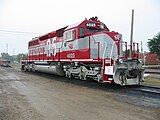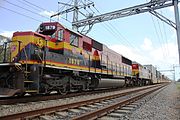HT-C truck
EMD#HTC 3Axle "C" bogie trucks were developed and successfully tested 1970~1971 with EMD#SD45X 6Axle "C-C" locomotives and then were made standard equipment in 1972 under EMD production locomotives, until superseded in 1993 by the EMD#HTCR bogie truck. As of this 2020 writing, EMD#HTC bogie trucks remain a common sight under operating locomotives in North America.
The most obvious external difference between the prior EMD#FlexicoilC and this EMD#HTC design is 2 holes versus 3 holes in the side frames between axles; this is due to differences in casting|machining technique and has no functional consequence. The EMD#HTC has 2 damping struts over the center bearings, four 72.00psi 496.5kpa brake cylinders over the outer bearings, and 6 composite brake shoes on the wheels; the inboard transom allows all 3 motors to mount the same direction, unlike the prior EMD#FlexicoilC. Secondary coils later changed from steel to hydrid rubber+steel, as with the FlexicoilC bogie truck. Significant improvements in tractive effort and weight shift during power|braking were achieved compared to prior designs.
-
EMD#HTC
Bogie Trucks On
EMD#SD40-2 UP#3637 -
EMD#HTC
Bogie Trucks On
EMD#SD38-2 LLPX#2808 -
EMD#HTC
Bogie Trucks On
EMD#SD40-2 WSOR#4025 -
EMD#HTC
Bogie Trucks On
EMD#SD40-2 BNSF#6731 -
EMD#HTC
Bogie Trucks On
EMD#SD60 Panama#1870
EMD#HTC bogie trucks typically have 56.50i 1.435m standard gauge wheel sets with 40.00i 1.016m tread diameters and 79.63 + 83.75 = 163.4i or 2.022 + 2.127 = 4.150m wheel base; early builds usually have Hyatt#6.500x12 roller bearings allowing for 65750Lb 29.82t AxleGRL and EMD#D77 trac motors; later builds typically have APcGG#6.500x12 tapered bearings that allow for 70000Lb 31.75t AxleGRL and EMD#D78 trac motors with transposed coils plus improved insulation; 62tAxleBull~15tMotorPinion gears are typical; maximum stable speed is typically 82MpHr 132KpHr.
Yawing effect controversy[edit]
When Amtrak bought their EMD SDP40Fs from 1972 to 1974, they specified this truck to be fitted with hollow bolsters to mount the engine on the trucks with a lighter load rating to offset the weight of the secondary water tank that was mounted in front of the steam generators. This purportedly contributed to a yawing effect which was characteristic of the second SDP in the consist and the baggage car. The result was that the unit and the car pulled the outside rail out from under the train on high speed curves.
Burlington Northern, Chessie System, and Louisville & Nashville banned the SDP40Fs because of the modified truck.
However, Santa Fe traded a larger number of lower-powered locomotives for the banned passenger SDP40Fs, on a horsepower-for-horsepower basis, replaced the hollow bolsters with conventional bolsters, removed the (above-frame) water tanks (replacing these with concrete ballast) and eliminated the (below-frame) fuel/water tank in favor of an all-fuel tank and it utilized these SDP40Fs in freight revenue service until their economic lifetime had been reached, after which they were stripped of usable service parts and the remainder of each were scrapped.
Conrail ordered their EMD SD40-2s and their early EMD SD50s with the older FlexicoilC trucks purportedly because of the HTC derailament issue.
The Federal Railroad Administration and Electro-Motive jointly determined that the baggage car was to blame, not the HTC bogie truck. The HTC went on to have a near flawless record on nearly every 6axle 40 Series, 50 Series and 60 Series model.
This early yaw problem did not doom the EMD#HTC as it did the EMD#SDP40F locomotive; this bogie truck design went under almost every EMD 6 axle locomotive built from 1972 to 1994, excepting Detroit Edison SD40s, Conrail SD40-2s and SD50s, Milwaukee Road SDL39s, EMD/BN/Siemens AG SD60MAC, and the EMD#SD70 and later models. As of this 2019 writing, the HTC bogie truck remains a common sight on operating locomotives in North America, original factory builds, later rebuilds, and new models; for example, EMD#SD59MX locomotives are rebuilt EMD#SD60Ms with new EMD#710ci engines and rebuilt EMD#HTC bogie trucks.
External links[edit]
See also[edit]
- Locomotive Bogie Truck EMD#HTCR+HTSC
- Locomotive Bogie Truck EMD#FlexiCoilC+D
- Locomotive Bogie Truck EMD#BlombergB+M+X
- Locomotive Bogie Truck EMD#BlombergA1A
- Locomotive Bogie Truck EMD#AARA
This article "HT-C truck" is from Wikipedia. The list of its authors can be seen in its historical and/or the page Edithistory:HT-C truck. Articles copied from Draft Namespace on Wikipedia could be seen on the Draft Namespace of Wikipedia and not main one.





